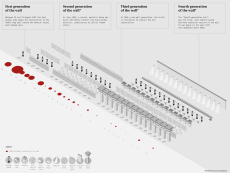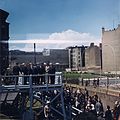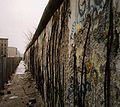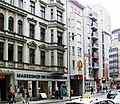Berlin Wall
barrier constructed by the German Democratic Republic, enclosing West Berlin | |||||
| Upload media | |||||
| Instance of | |||||
|---|---|---|---|---|---|
| Part of | |||||
| Named after | |||||
| Made from material | |||||
| Location |
| ||||
| Commissioned by | |||||
| Heritage designation | |||||
| Inception |
| ||||
| Dissolved, abolished or demolished date |
| ||||
| Significant event |
| ||||
| Length |
| ||||
| Height |
| ||||
| Cost |
| ||||
| Different from | |||||
| Said to be the same as | Anti-Fascist Protection Rampart | ||||
| official website | |||||
 | |||||
| |||||
Historical pictures
[edit]-
Before, on Friday, August 11, 1961
-
border guards at Brandenburg Gate on August 13, 1961, the day the Berlin Wall was erected
-
Waving over the Berlin Wall
-
East German construction workers building the Berlin Wall, 1961-11-20
-
John F. Kennedy visiting the Berlin Wall at Checkpoint Charlie, June 26, 1963
-
Kennedy at the Brandenburg Gate
-
English: On the east side 1968 the "Baby-Wall" with flowers.Deutsch: Blumenschalensperre
-
President Nixon visits the Wall at Moritzplatz, February 27, 1969
-
Potsdamer Platz and Stresemannstraße, November 1975
-
Wall at Bernauer Straße with Versöhnungskirche in death strip, January 12, 1978
-
border section at corner of Liesenstraße and Nordbahnhof on St. Hedwig cemetery (1980)
-
1980
-
President Reagan with West Berlin mayor von Weizsäcker and Chancellor Schmidt at Checkpoint Charlie (June 11, 1982)
-
entering plaque, at "Glienicker Brücke", 1985
-
leaving plaque, at "Glienicker Brücke", 1985
-
death strip & graffiti at Bethaniendamm in Kreuzberg (1986)
-
Parade in East Berlin celebrating the 25th anniversary of the erection of the Berlin Wall, 1986
-
1987
-
Ronald Reagan speaking in front of the Berliner Mauer on 1987-06-12
-
President Ronald Reagan giving a speech at the Berliner Mauer, Brandenburger Tor, 1987-06-12
-
1989-06
-
Soldier on the wall - 1989-11
-
border guards feeding birds on watchtower, November 14, 1989
-
border guards feeding birds on watchtower, November 14, 1989
-
Berlin Wall on 1989-11-16
-
Juggling on the Berlin Wall on 1989-11-16
-
(2)
-
(3)
-
(3)
-
1989-12-01
-
A crane removing a section of the Berlin Wall on December 21, 1989
-
East German Volkspolizei at ceremony for the official opening of the Brandenburg Gate, December 22, 1989
-
January 1990:Deutsch: Symbolische Grabkreuze für die Opfer der Mauer
-
1990
-
1990
-
dismantling of the Wall at Brandenburg Gate, February 1990
-
damaged wall at Checkpoint Charlie, July 1990
-
Former US President Ronald Reagan is presented a now obsolete checkpoint sign at Tempelhof Airport in Sep 1990.
-
Kubat-Dreieck on the Berlin Wall, June 1988
-
Kubat-Dreieck on the Berlin Wall, taken by police, July 1st 1988
-
Berlin Wall, eastgerman border guard looks at the Kubat-Dreieck, July 1st 1988
Photos Taken after 1990
[edit]Remaining Parts of Front Wall
[edit]The term „Berlin Wall“ describes both the fortifications at the border around West Berlin in general as well as the front wall („Vorderes Sperrelement“) of the „death strip“ in particular. Only three shorter front wall sections (at Niederkirchnerstraße, at Bernauer Straße and at Liesenstraße) still exist.
-
at Bernauer Straße
-
from top of tower at Bernauer Straße
-
at Liesenstraße, situated on top of the old wall of St. Hedwig cemetery
-
at Liesenstraße; this is the shortest of the three remaining front wall sections
-
remnant of the 1961 „first generation“ of the Berlin Wall at Liesenstraße
-
at Niederkirchnerstraße
-
at Niederkirchnerstraße
-
at Niederkirchnerstraße
-
at Niederkirchnerstraße
-
at Niederkirchnerstraße
-
at Niederkirchnerstraße
-
at Niederkirchnerstraße
-
at Niederkirchnerstraße
Run of Removed Front Wall
[edit]On public streets and places, the run of removed parts of the front wall is marked by double cobblestone rows and copper strips throughout Berlin. At some places like Potsdamer Platz, segments removed at other parts of the Wall serve the same purpose.
-
in Alt-Treptow, near Lohmühlenbrücke
-
in Alt-Treptow, near Lohmühlenbrücke
-
at corner of Bellevuestraße and Ebertstraße
-
at Sonnenallee
-
near Checkpoint charlie
-
at Ebertstraße, near the Holocaust Memorial
-
at Kapelleufer, near Berlin Central Station
-
Wall segment marking the run of the Wall at Potsdamer Platz
-
Wall segment marking the run of the Wall at Potsdamer Platz
-
Wall segment marking the run of the Wall at Potsdamer Platz
-
Wall segment marking the run of the Wall at Potsdamer Platz
-
Brandenburg Gate
Rear Wall
[edit]A rear wall („Hinterlandmauer“ or „Hinterlandsicherungsmauer“) or a rear fence secured the „death strip“ on the East Berlin side. The rear wall was usually smaller than the front wall. However, remaining stretches of the rear wall are often mistaken for front wall sections where they have the same height and outlook (e.g. at Potsdamer Platz and at Mühlenstraße). Shorter and longer segments of the rear wall remain in place throughout Berlin, by far the longest and most prominent forming the 1,300 meters long „East Side Gallery“ at Mühlenstraße.
-
East Side Gallery
-
God! Help me survive amid this mortal love, by Dmitri Vrubel, 1989
-
East Side Gallery
-
East Side Gallery
-
East Side Gallery
-
rear wall at Invalidenfriedhof cemetery with display boards telling the history of this border section
-
near Potsdamer Platz
-
rear wall near Potsdamer Platz in 1998 (since removed)
-
rear wall remnant with gate leading to the former death strip (in front) at Chausseestraße
-
As a memorial on a graveyard, Kaiser-Wilhelm-Gedächtnis-Friedhof
Watchtowers
[edit]Border guards oversaw the „death strip“ from watchtowers, 302 of which ringed West-Berlin in 1989. A group of watchtowers was controlled by guards on the more massive directing towers („Führungsstellen“). Only two ordinary watchtowers are still standing, both of which have been removed from their original sites. Three directing towers remain in place.
-
directing tower „Schlesischer Busch“ in Alt-Treptow
-
directing tower „Kieler Eck“ in Berlin-Mitte
-
directing tower at Hennigsdorf, northwest of Berlin
-
watchtower near Potsdamer Platz (relocated)
-
watchtower Type BT-11 near Potsdamer Platz (relocated)
-
watchtower graffiti on border wall at St. Hedwig cemetery, scratched in fresh concrete in 1974
Other Parts of Border Fortifications
[edit]-
concrete wall on St. Hedwig cemetery, erected in 1974 to secure the front area („Vorfeldsicherung“)
-
patrol road of the „death strip“ near the corner of Liesenstraße and Chausseestraße
-
patrol road on Invalidenfriedhof cemetery; marked as part of the Berlin Wall Path („Berliner Mauerweg“)
-
waste land on former border strip in Berlin Mitte, along Stallschreiberstraße, with patrol road on the right
-
Japanese Cherry alley, Berlin Wall Trail, near former Bornholmer Strasse border crossing
Museums, Memorials and Art
[edit]-
official Berlin Wall memorial at Bernauer Straße
-
new chapel of Versöhnungskirche, Bernauer Straße
-
Memorial in Berlin-Treptow, remembering 15 killed refugees from Treptow, including two boys
-
memorial tablet for Ida Siekmann, the first Wall victim (died August 1961), at Bernauer Straße
-
memorial tablet for Wall victim Bernd Lünser (died October 1961) at Bernauer Straße
-
memorial tablet for Wall victim Olga Segler (died September 1961) at Bernauer Straße
-
memorial for graves removed in the death strip at Alter Domfriedhof cemetery, Liesenstraße
-
sculpture „Wiedervereinigung“ (“reunification”) by Hildegard Leest (1962), near former border crossing Chausseestraße[1]
-
memorial stone for Günter Litfin, first person shot to death at the Berlin Wall in 1961; situated at former border crossing Invalidenstraße
-
Wall museum („Mauermuseum“) at Checkpoint Charlie
-
crosses for victims of the Wall (1990)
-
unofficial memorial for victims of the Wall near Checkpoint Charlie (removed)
-
cross for Wall victim Peter Fechter at the unofficial memorial for victims of the Wall near Checkpoint Charlie (removed)
-
memorial for Peter Fechter, shot to death in 1962, situated at Zimmerstraße
-
memorial for Peter Fechter, inscription
-
memorial for Peter Fechter, back side
-
removed segment of the wall, standing near Checkpoint Charlie
-
The Day the Wall Came Down in Berlin-Zehlendorf, sculpted by Veryl Goodnight (1998), a gift from the people of the United States
-
Art in city hall of Berlin-Spandau, Carl-Schurz-Straße 26, Berlin-Spandau
-
Memorial Stone (segment of the wall) at "Platz des 9. November 1989", former Bornholmer Strasse border crossing
-
Falkplatz, Berlin-Prenzlauer Berg
-
White Crosses, Ebertstraße, Berlin-Tiergarten
-
Edelhofdamm, Berlin-Frohnau
-
Knesebeckbrücke, Berlin-Zehlendorf
-
Knesebeckbrücke, Berlin-Zehlendorf
-
White Crosses, Reichstagsufer, Berlin-Mitte
-
May-Ayim-Ufer, Berlin-Kreuzberg
-
Erdmann-Graeser-Weg, Berlin-Zehlendorf
Parts of the Berlin Wall in Other Towns
[edit]-
Brussels
-
Caen
-
Gdansk
-
Koblenz
-
London, Imperial War Museum
-
Montréal, Centre de Commerce Mondial
-
Oberstdorf
-
Simi Valley, Ronald Reagan Presidential Library
-
Schengen
Maps / satellite images
[edit]-
Satellite image with the position of the wall
-
Map
-
Map (German)
-
Map (English)
-
Map (French)
-
Map (Portuguese)
-
Map (Español)
-
Map (Hungarian)
See also
[edit]- Iron Curtain
- Some articles about the victims in de:Kategorie:Opfer an der innerdeutschen Grenze
- Checkpoint Charlie
- East Side Gallery






























































































































![sculpture „Wiedervereinigung“ (“reunification”) by Hildegard Leest (1962), near former border crossing Chausseestraße[1]](https://upload.wikimedia.org/wikipedia/commons/thumb/1/16/Skulptur_Wiedervereinigung%2C_Hildegard_Leest_1962.jpg/120px-Skulptur_Wiedervereinigung%2C_Hildegard_Leest_1962.jpg)

































